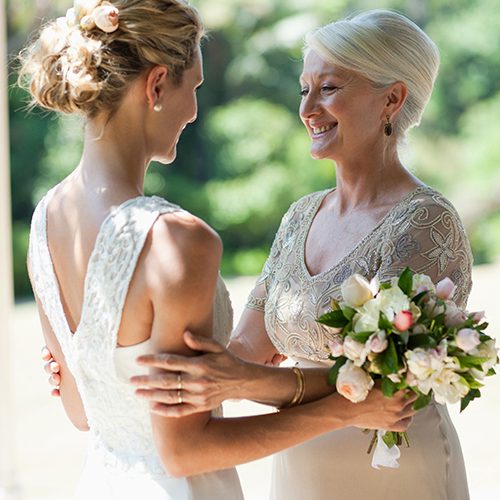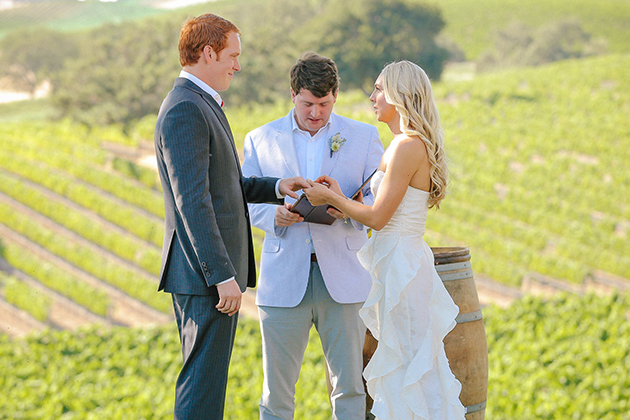Deciding what to do about your wedding vows can be tricky. For those having a more traditionally religious wedding, the vows are already built in. But whether or not you’re having a religious or cultural wedding, these traditional wedding vows below may inspire you to add a variety of faiths into your own wedding ceremony.
Jewish
During a traditional Jewish wedding, the bride and groom may say these words as they exchange rings:
In Hebrew: Ani L’Dodi, v’Dodi Li
In English: I am my beloved’s and my beloved is mine.
Along with the ring exchange, the seven blessings, or Sheva Berakhot, are typically recited by your rabbi, cantor, or family members, in English or Hebrew.
Hindu
There are 15 specific rituals followed in a traditional a Hindu wedding ceremony, one being the Seven Steps, or Saptha Padhi. In this tradition, the bride and groom walk around a flame (honoring Agni, the fire god). The prayers that are recited during this walk are the promises the couple is making to each other for their future:
Let us take the first step to provide for our household a nourishing and pure diet, avoiding those foods injurious to healthy living.
Let us take the second step to develop physical, mental, and spiritual powers.
Let us take the third step to increase our wealth by righteous means and proper use.
Let us take the fourth step to acquire knowledge, happiness, and harmony by mutual love and trust.
Let us take the fifth step so that we are blessed with strong, virtuous, and heroic children.
Let us take the sixth step for self-restraint and longevity.
Finally, let us take the seventh step and be true companions and remain lifelong partners by this wedlock.
Muslim
Typically, Muslim couples do not exchange vows during the ceremony. Instead, the imam will ask the bride and groom if they accept each other in terms of their marriage contract, or Nikah, three times. Once the couple answers that they do, all three times, they sign the Nikah. If exchanging vows is important to you and your fiancé, discuss options with your imam for proper wording.
Protestant, Episcopal
Traditional Protestant and Episcopal wedding vows may be the most familiar to you. If you’re nervous about slipping up, ask your cleric to perform the vows in a read-and-repeat style.
In the name of God, I, (groom/bride’s name), take you, (groom/bride’s name), to be my (husband/wife), to have and to hold from this day forward, for better, for worse, for richer, for poorer, in sickness and in health, to love and to cherish, until we are parted by death. This is my solemn vow.
Methodist
These vows are more of a call and response. The only words a bride and groom have to remember to be wedded: “I do.”
Officiant: “Will you have this (woman/man) to be your (wife/husband), to live together in holy marriage? Will you love (her/him), comfort (her/him), honor, and keep (her/him) in sickness and in health, and forsaking all others, be faithful to (her/him) as long as you both shall live?”
Bride/Groom: “I do”
Lutheran
Similar to other Christian religions, Lutheran vows can be read by your officiant and repeated if you are worried about missing your lines.
I, ______, take you, ______, to be my (wife/husband), and these things I promise you: I will be faithful to you and honest with you; I will respect, trust, help, and care for you; I will share my life with you; I will forgive you as we have been forgiven; and I will try with you better to understand ourselves, the world, and God; through the best and worst of what is to come, and as long as we live.
Baptist
There are two options for traditional Baptist vows. The first is a call and response from your officiant:
Officiant: “Will you, ______ have ______ to be your (wife/husband)? Will you love her/him, comfort and keep her/him, and forsaking all others remain true to her/him, as long as you both shall live?”
Bride/Groom: “I will.”
Your other option is a shorter version of vows—one line said by both bride and groom:
I, ______, take thee, ______, to be my (wife/husband), and before God and these witnesses I promise to be a faithful and true (husband/wife).
Catholic
Before you get to your vows, Catholic brides and grooms usually have to answer three questions from the priest:
“(Name) and (name), have you come here freely and without reservation to give yourselves to each other in marriage?”
“Will you honor each other as man and wife for the rest of your lives?”
“Will you accept children lovingly from God, and bring them up according to the law of Christ and his Church?”
You will respond with either “I will” or “yes,” then continue onto the vows themselves:
I, (name), take you, (name), to be my (husband/wife). I promise to be true to you in good times and in bad, in sickness and in health. I will love you and honor you all the days of my life.
Buddhist
In the Tibetan Buddhist tradition, the bride and groom answer the first set of vows read by the officiant together. The vows are longer than in many other religions, but create a sense of companionship as the couple respond in unison.
Officiant: (Bride’s first name) and (groom’s first name) do you pledge to help each other to develop your hearts and minds, cultivating compassion, generosity, ethics, patience, enthusiasm, concentration and wisdom as you age and undergo the various ups and downs of life and to transform them into the path of love, compassion, joy and equanimity?
Bride/Groom: “We do”
Officiant: Recognizing that the external conditions in life will not always be smooth and that internally your own minds and emotions will sometimes get stuck in negativity, do you pledge to see all these circumstances as a challenge to help you grow, to open your hearts, to accept yourselves, and each other; and to generate compassion for others who are suffering?
Bride/Groom: “We do”
Officiant: Understanding that just as we are a mystery to ourselves, each other person is also a mystery to us, do you pledge to seek to understand yourselves, each other, and all living beings, to examine your own minds continually and to regard all the mysteries of life with curiosity and joy?
Bride/Groom: “We do”
Officiant: Do you pledge to preserve and enrich your affection for each other, and to share it with all beings? To take the loving feelings you have for one another and your vision of each other’s potential and inner beauty as an example and rather than spiraling inwards and becoming self absorbed, to radiate this love outwards to all beings?
Bride/Groom: “We do”
Officiant: When it comes time to part, do you pledge to look back at your time together with joy- joy that you met and shared what you have-and acceptance that we cannot hold on to anything forever?
Bride/Groom: “We do”
Officiant: Do you pledge to remember the disadvantages of ignorance, anger and clinging attachment, to apply antidotes when these arise in your minds, and to remember the kindness of all other beings and your connection to them? Do you pledge to work for the welfare of others, with all of your compassion, wisdom and skill?
Bride/Groom: “We do”
Officiant: Do you pledge day to day, to be patient with yourselves and others, knowing that change comes slowly and gradually, and to seek inspiration from your teachers not to become discouraged?
Bride/Groom: “We do”
Then the bride and groom may be asked to make their separate vows.
Officiant: Do you, (groom/bride’s name) promise to love, cherish and work day and night to bring total happiness to (groom/bride’s name)? Do you promise to practice generosity, morality, patience, and joy in all you do; mindfulness and wisdom to treat (groom/bride’s name) and all others with loving kindness and compassion, for all the time you are together, knowing that this marriage can only be as good as the two of you make it.
Bride/Groom: I do.”
Native American (Apache)
In Apache tradition, there may not be exchanging of vows. However, a wedding blessing is read to the couple:
Now you will feel no rain, for each of you will be shelter for the other. Now you will feel no cold, for each of you will be warmth to the other. Now there will be no loneliness, for each of you will be companion to the other. Now you are two persons, but there is only one life before you. May beauty surround you both in the journey ahead and through all the years. May happiness be your companion and your days together be good and long upon the earth.
Treat yourselves and each other with respect, and remind yourselves often of what brought you together. Give the highest priority to the tenderness, gentleness and kindness that your connection deserves. When frustration, difficulties and fear assail your relationship, as they threaten all relationships at one time or another, remember to focus on what is right between you, not only the part which seems wrong. In this way, you can ride out the storms when clouds hide the face of the sun in your lives — remembering that even if you lose sight of it for a moment, the sun is still there. And if each of you takes responsibility for the quality of your life together, it will be marked by abundance and delight.
Native American (Cherokee)
In another Native American tradition, Cherokee also read a beautiful wedding blessing to their brides and grooms:
God in heaven above please protect the ones we love. We honor all you created as we pledge our hearts and lives together. We honor Mother Earth and ask for our marriage to be abundant and grow stronger through the seasons. We honor fire and ask that our union be warm and glowing with love in our hearts. We honor wind and ask that we sail through life safe and calm as in our father’s arms. We honor water to clean and soothe our relationship — that it may never thirst for love. With all the forces of the universe you created, we pray for harmony as we grow forever young together. Amen.
See More: Nonreligious Wedding Ceremony Reading Ideas










